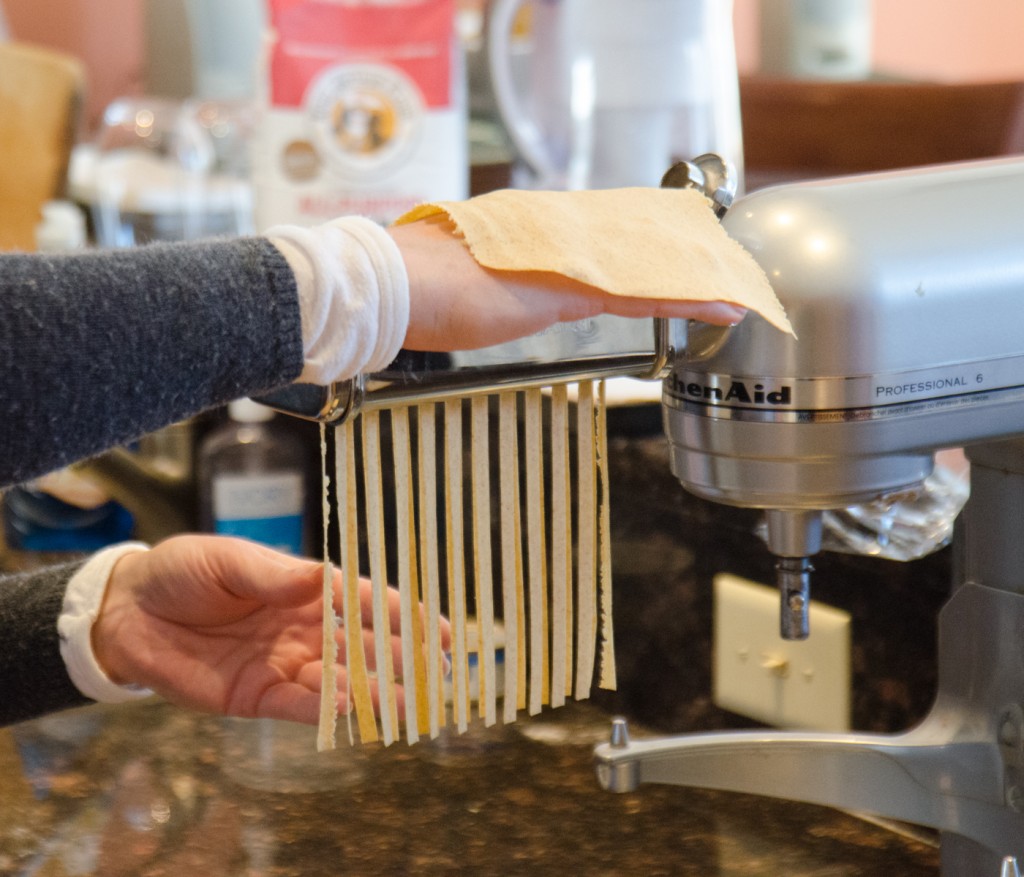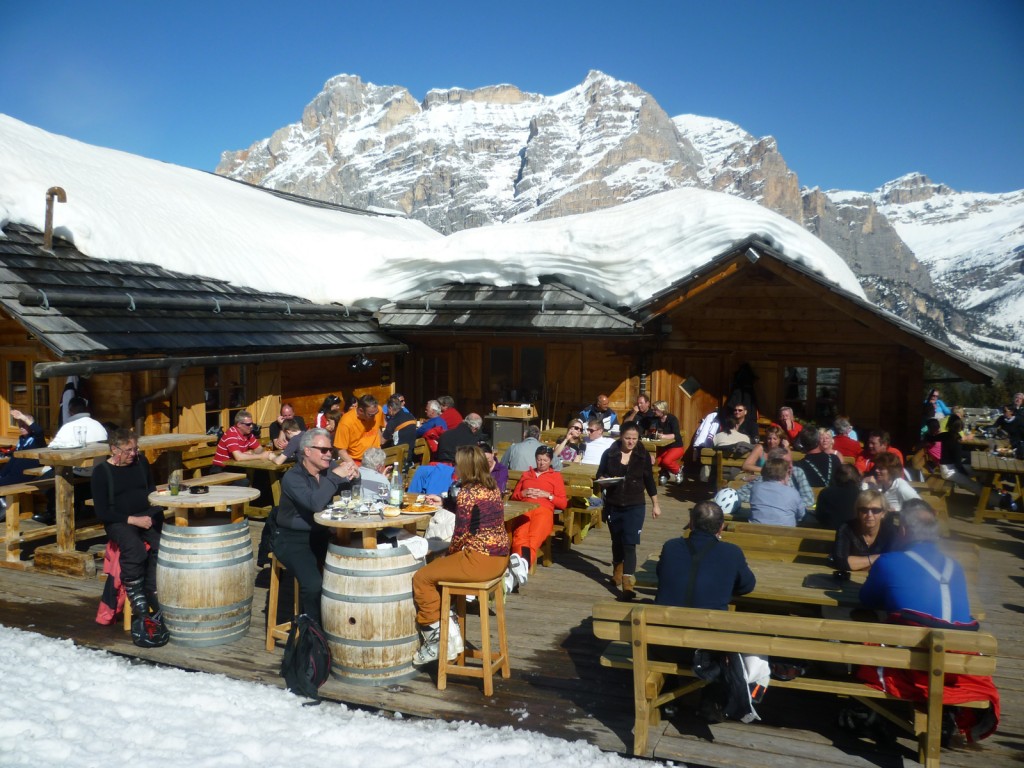 Recently, we led a private group on a gourmet Dolomites ski holiday, spending a fantastic week skiing and dining in lovely Cortina. While visiting the slopes at Alta Badia, we came across a local recipe book featuring recipes from the many wonderful rifugios and hotels in and around Alta Badia. I love bringing these home and recreating the dishes in my own kitchen.
Recently, we led a private group on a gourmet Dolomites ski holiday, spending a fantastic week skiing and dining in lovely Cortina. While visiting the slopes at Alta Badia, we came across a local recipe book featuring recipes from the many wonderful rifugios and hotels in and around Alta Badia. I love bringing these home and recreating the dishes in my own kitchen.
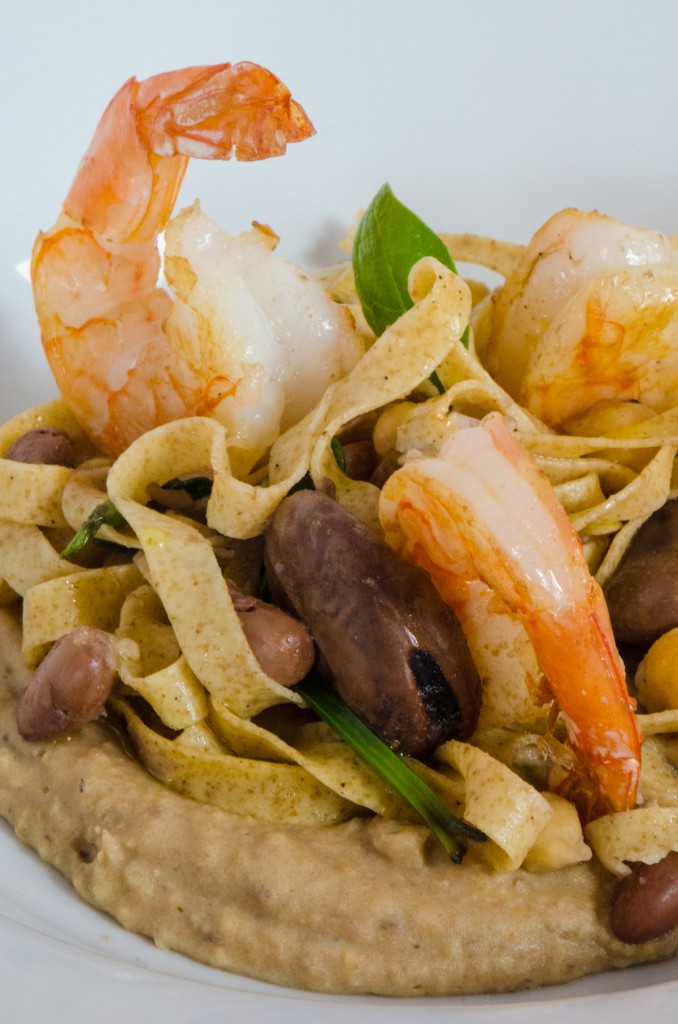 One recipe for a fresh pasta caught my attention – a recipe from Hotel Diamant, Tagliatelle con Spinaci Selvatici. The ingredients included grano arso semolina flour, or burnt wheat flour. I had never seen this used outside of Puglia, so to find it included on the menu in Trentino took me by surprise. But it has always intrigued me, so it was time to try it.
One recipe for a fresh pasta caught my attention – a recipe from Hotel Diamant, Tagliatelle con Spinaci Selvatici. The ingredients included grano arso semolina flour, or burnt wheat flour. I had never seen this used outside of Puglia, so to find it included on the menu in Trentino took me by surprise. But it has always intrigued me, so it was time to try it.
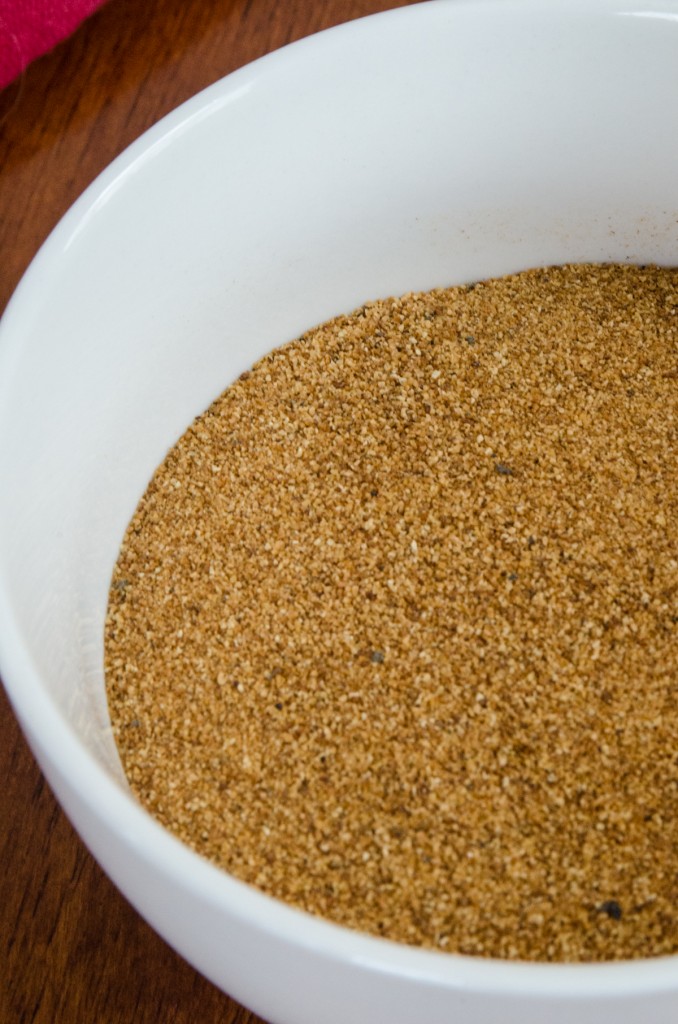 The origin of grano arso is embedded in the traditional cucina povera – cuisine of the poor or peasants – that you see in every region of Italy. In Puglia, poor field workers labored to produce durum flour for their estate owners. Following the harvest, the fields would be burned to prepare them for next season’s planting. Afterwards, the farmers would search the fields for any remaining burnt wheat kernels, gathering them and grinding them into a burnt wheat flour (grano arso), and used in the preparation of bread and pasta. Pasta made with the flour would be called pasta nero, or black pasta. Traditionally in Puglia, it would be orecchiette with broccoli rabe.
The origin of grano arso is embedded in the traditional cucina povera – cuisine of the poor or peasants – that you see in every region of Italy. In Puglia, poor field workers labored to produce durum flour for their estate owners. Following the harvest, the fields would be burned to prepare them for next season’s planting. Afterwards, the farmers would search the fields for any remaining burnt wheat kernels, gathering them and grinding them into a burnt wheat flour (grano arso), and used in the preparation of bread and pasta. Pasta made with the flour would be called pasta nero, or black pasta. Traditionally in Puglia, it would be orecchiette with broccoli rabe.
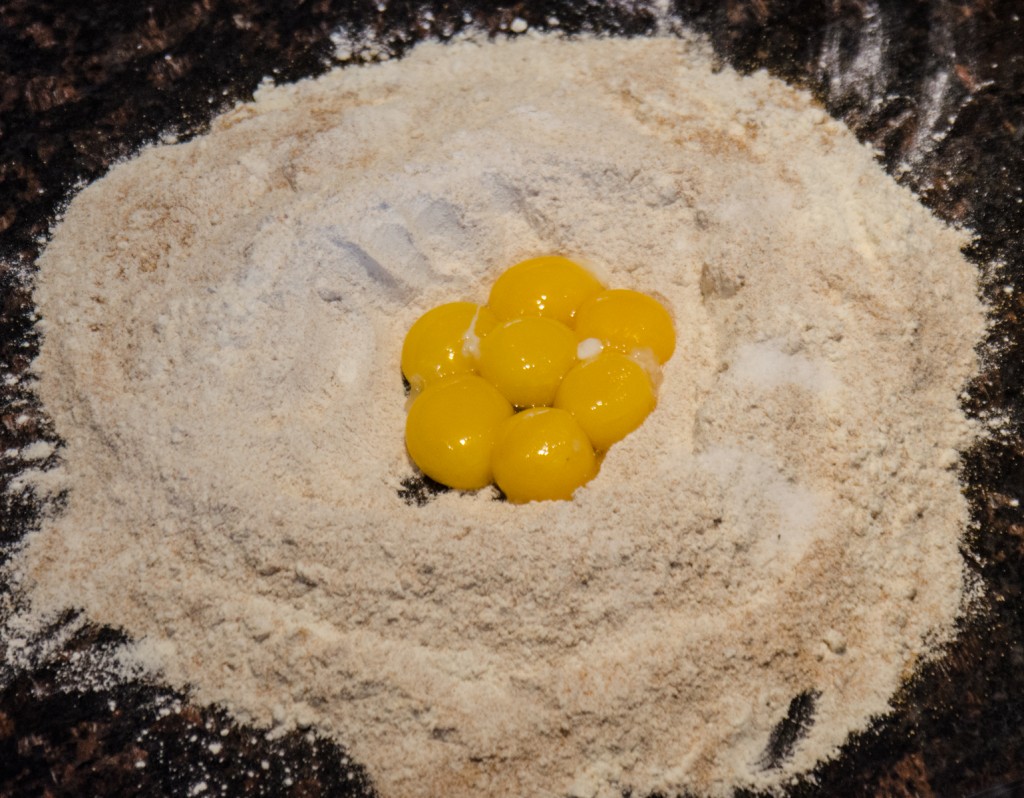 In modern times, with flour inexpensive and easily available, the use of grano arso had all but disappeared. However, the Slow Food movement has resurrected traditional foods like this, and recently a company called Pivetti in Bologna started producing a modern version of scorched flour, roasting hard wheat just like coffee. They are marketing it to chefs in the US, so I suspect that is how it has made it’s way up to Trentino. But the idea of incorporating the nutty flavor of grano arso into a pasta certainly sounded enticing, and fairly straightforward to include.
In modern times, with flour inexpensive and easily available, the use of grano arso had all but disappeared. However, the Slow Food movement has resurrected traditional foods like this, and recently a company called Pivetti in Bologna started producing a modern version of scorched flour, roasting hard wheat just like coffee. They are marketing it to chefs in the US, so I suspect that is how it has made it’s way up to Trentino. But the idea of incorporating the nutty flavor of grano arso into a pasta certainly sounded enticing, and fairly straightforward to include.
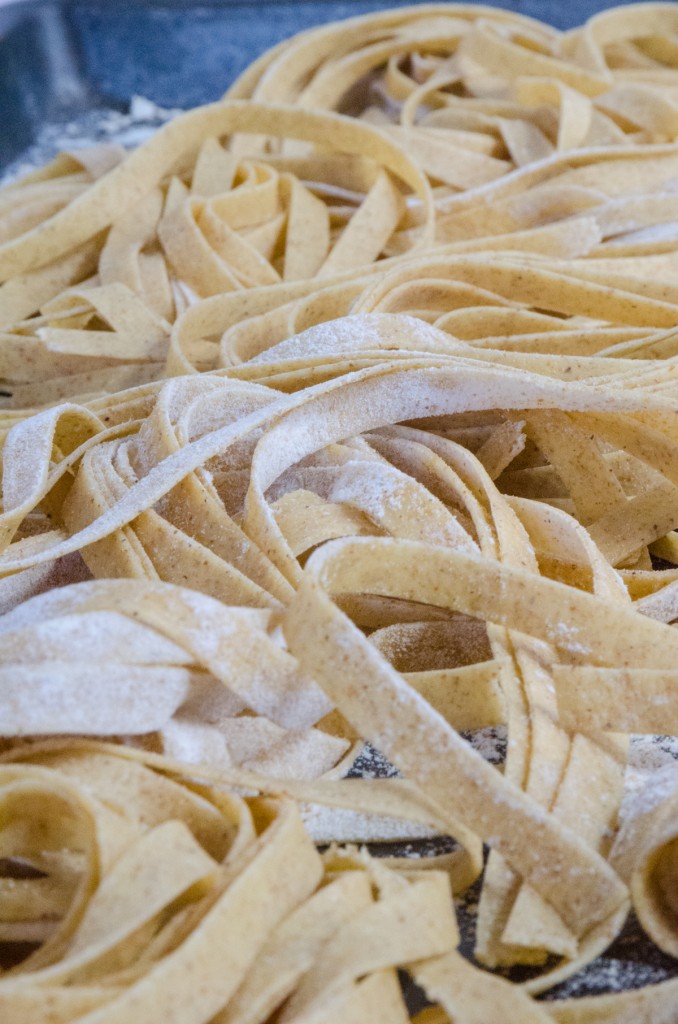 Grano Arso flour still is almost impossible to find in the grocers, but it is something pretty simple to do at home. The recipe below includes instructions on toasting the flour – basically spread it on a sheet pan and toast in the oven. Just keep an eye on it, removing from the oven to shake and redistribute so it toasts evenly and doesn’t burn.
Grano Arso flour still is almost impossible to find in the grocers, but it is something pretty simple to do at home. The recipe below includes instructions on toasting the flour – basically spread it on a sheet pan and toast in the oven. Just keep an eye on it, removing from the oven to shake and redistribute so it toasts evenly and doesn’t burn.
Tagliatelle di Grano Arso con Spinaci, Gambero e Mille Fagioli
1.5 cups durum wheat flour
1/2 cup burnt wheat (grano arso) semolina flour (directions below)
8 egg yolks
2 eggs
2 ounces dried borlotti beans
2 ounces dried fava beans
2 ounces dried chick peas
2 ounces pancetta
1 medium carrot, 1/4” dice
1 onion, 1/4” dice
1 celery stalk, peeled and 1/4” dice
1 potato, cut into 1” dice
2 cloves garlic, minced
3 bay leaves
Kosher salt and freshly ground pepper
12 large shrimp
8 ounces baby spinach
Preparing the grano arso flour:
Spread the semolina flour out on a sheet pan. Toast in a warm oven (375°F) until golden brown. Remove from the oven every 7 – 10 minutes to shake, and make sure it doesn’t burn.
Making the dough:
Light, delicate pasta comes from working the dough as much as possible to develop the elasticity of the flour’s protein, or gluten. Kneading and then gradually rolling, stretching and thinning the dough lengthens the gluten strands, producing tender and resilient pasta. Shortcutting the process results in heavy noodles. There is nothing difficult here, but like any craft the pleasure of achievement comes from learning a few basics and then practicing. Take time to work the dough well and it will pay you back tenfold in dining pleasure.
Mound the flour in the center your counter. Make a well in the middle. Add the eggs, and using a fork, beat until well mixed. Gradually start incorporating a bit of the flour from the sides of the well into the eggs. As you continue to work the flour into the eggs, the sides of the well may collapse. Use a pastry scraper to keep the liquids from running off and to incorporate the last bits of flour into the dough. Do not worry if it looks like a mess at this point!
With the aid of the scraper to scoop up any pieces, start kneading the dough. Once it becomes a cohesive mass, use the scraper to remove any bits of hard flour from the work surface. Knead the dough about 3 minutes. It should be elastic and a little sticky. If it is too sticky to move easily, knead in a few more tablespoons of flour. Continue kneading 10 minutes, or until the dough has become satiny, smooth, and very elastic. Poke your finger into the dough – if the indentation made by your finger does not disappear, continue to knead. Wrap the dough in plastic wrap and allow to rest at room temperature for 30 minutes to 3 hours. Skipping this rest step does not have much effect, according to Kasper. I skip it all the time.
Work with one fifth of the dough at a time, keeping the rest wrapped. Lightly flour the machine rollers and the work surface around the machine. Set the rollers at the widest setting. Flatten the dough into a thick patty. Guide it through the rollers by inserting one end into the space between the two rollers. Turn the crank handle with one hand while holding the upturned palm of your other hand under the sheet emerging from the rollers. Keep your palm flat to protect the dough from punctures by your fingers.
As the emerging sheet lengthens, guide it away from the machine with your palm. Pass the dough through the rollers five to six times, folding it in thirds each time. Then set the rollers at the next narrower setting and pass the dough through three times, folding it in half each time. Repeat, passing it through three times at each successively narrower setting. Repeated stretching and thinning builds up elasticity making especially light pasta. If the sheet becomes too long to handle comfortably, cut it in half or thirds and work the pieces in tandem.
Don’t worry if at first the dough tears, has holes, is lumpy, or is very moist. Just lightly flour it by pulling the dough over the floured work surface. As you keep putting it through the rollers, it will be transformed from slightly lumpy and possibly torn to a smooth, satiny sheet with fine elasticity.
For cut pastas like tagliatelle, continue rolling the sheets until you reach the second or third to narrowest settings; the thickness you wish your finished pasta to be. If you have a pasta cutter on your pasta machine, use that to cut it into strips. If you don’t, fold the sheet into quarters and cut into strips with a sharp knife. Spread on a floured sheet pan, and cover with plastic wrap. Continue until all the dough is processed into tagliatelle.
For the sauce:
In separate bowls, soak the various beans overnight in cold water.
Drain all the beans. Put each type of bean in a separate saucepan. Divide the pancetta, carrot, onion, celery, potato and 1 clove of garlic between the three saucepans. Cover with cold water. Season with salt and pepper, and add a bay leaf to each. Place each saucepan over medium high heat, turning down to a simmer when they begin to bowl. Cook until the beans are tender, they will cook at different rates. Drain the beans, reserving the cooking liquid. Pull half of each batch of beans out of the vegetables and reserve.
Place the remaining beans with the vegetables into a food processor, add 2 tablespoons of the olive oil and puree until smooth, adding the reserved cooking liquid as necessary. Keep warm.
Bring a large pot of water to boil over high heat.
Meanwhile, heat 1 tablespoon of the olive oil in a sauté over medium high heat. Add the shrimp, season with salt and pepper and sauté until just cooked through. Remove from heat and keep warm.
Add the remaining tablespoon of olive oil to the sauté pan. Add the spinach, and cook until wilted. Add the remaining garlic and cook for another minute. Season with salt and pepper.
Salt the boiling water. Cook the tagliatelle until al dente.
Add the reserved whole beans and the shrimp to the spinach in the sauté pan.
Place a pool of the bean puree on the bottom of each serving dish. Top with the tagliatelle. Place the spinach, whole beans and shrimp (3 shrimp per serving) over the pasta. Drizzle with olive oil, and serve.
